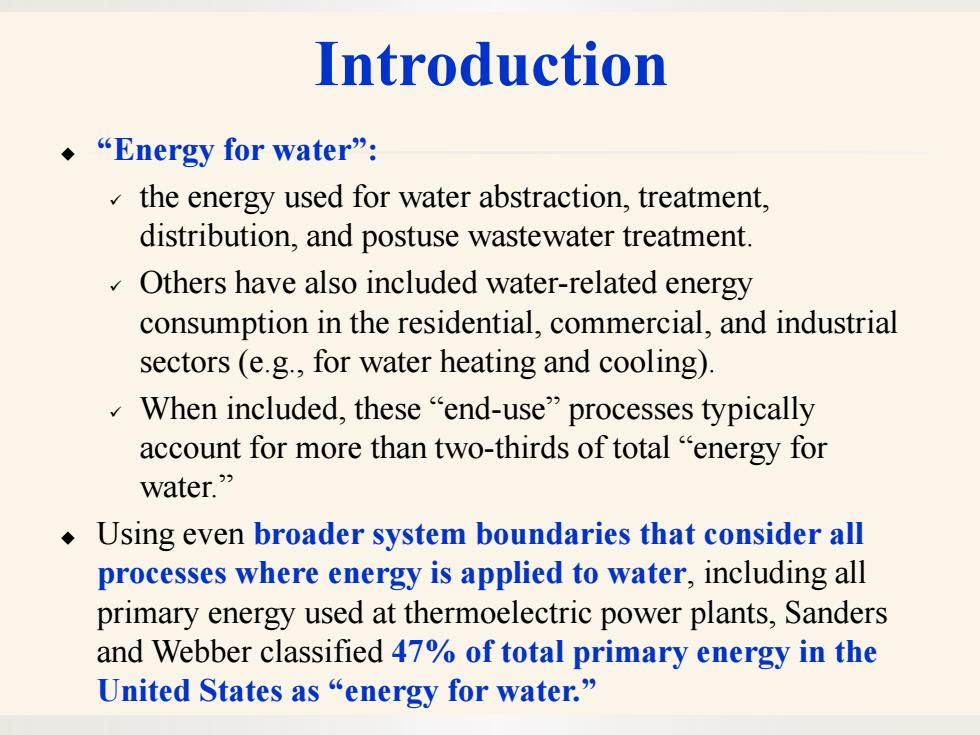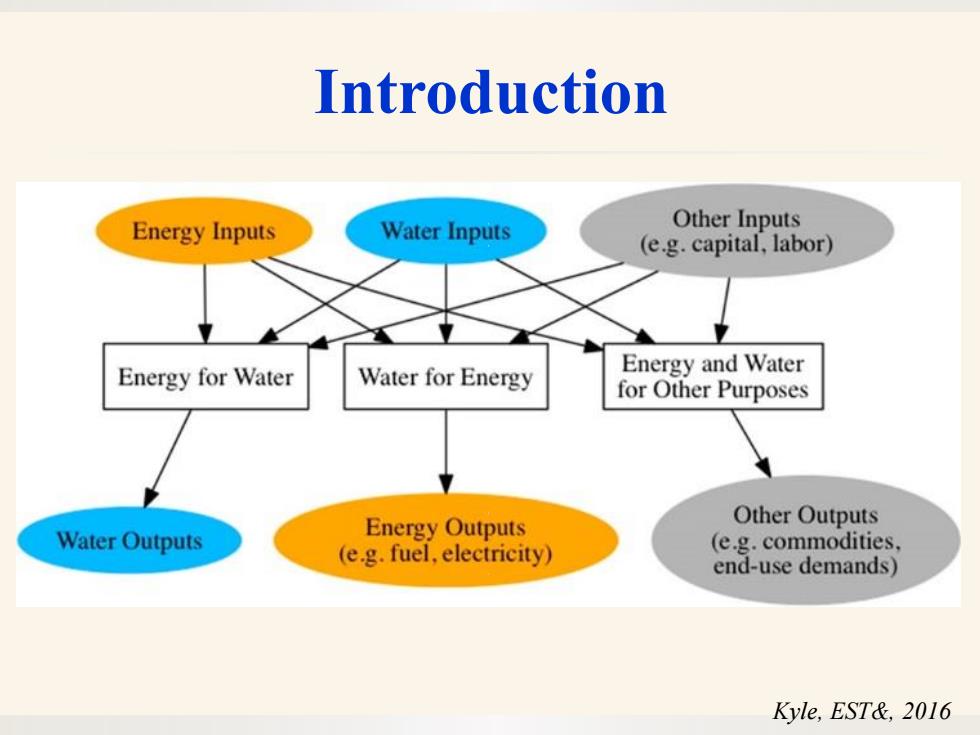
Introduction ◆“water-energy nexus: generally defined as the interdependency between water and energy in their supply,processing,distribution,and use. Two components of water-energy nexus: “water for energy'and“energy for water.” ◆“water for energy”: water required for the extraction,processing,and transformation of energy as well as the irrigation of bioenergy There has been less agreement on the definition and system boundaries of“energy for water
Introduction ◆ “water-energy nexus: ✓ generally defined as the interdependency between water and energy in their supply, processing, distribution, and use. ◆ Two components of water-energy nexus: ✓ “water for energy” and “energy for water.” ◆ “water for energy”: ✓ water required for the extraction, processing, and transformation of energy as well as the irrigation of bioenergy ◆ There has been less agreement on the definition and system boundaries of “energy for water

Introduction ◆“Energy for water'": the energy used for water abstraction,treatment, distribution,and postuse wastewater treatment. Others have also included water-related energy consumption in the residential,commercial,and industrial sectors (e.g.,for water heating and cooling). When included,these"end-use"processes typically account for more than two-thirds of total "energy for water." Using even broader system boundaries that consider all processes where energy is applied to water,including all primary energy used at thermoelectric power plants,Sanders and Webber classified 47%of total primary energy in the United States as“energy for water
Introduction ◆ “Energy for water”: ✓ the energy used for water abstraction, treatment, distribution, and postuse wastewater treatment. ✓ Others have also included water-related energy consumption in the residential, commercial, and industrial sectors (e.g., for water heating and cooling). ✓ When included, these “end-use” processes typically account for more than two-thirds of total “energy for water.” ◆ Using even broader system boundaries that consider all processes where energy is applied to water, including all primary energy used at thermoelectric power plants, Sanders and Webber classified 47% of total primary energy in the United States as “energy for water

Introduction Energy Inputs Water Inputs Other Inputs (e.g.capital,labor) Energy for Water Water for Energy Energy and Water for Other Purposes Other Outputs Water Outputs Energy Outputs (e.g.fuel,electricity) (e.g.commodities, end-use demands) Kyle,EST&,2016
Kyle, EST&, 2016 Introduction

The Water-Energy Nexus Energy is used for pumping water Water used for mining fuels Water supply uses energy Enorgy used in water/wastewater treatment 0 Water Flows Water and energy use mage from"Energy Demands on Water Resources," in the home are related U.S.Department of Energy,2006(pg.13) Energy Flows

1.9EJ Global energy for water in 2010 source and conveyance 2.5EJ (4.0EJ) 0.3EJ 0.6E 1.4EJ 1.0EJ water 05E 0.9Ej 0.9EJ 1.7EJ 1.0EJ distribution (1.2EJ) 1.2EJ industry (3.1EJ ground- water (3.1EJ wastewater collection (0.2EJ 1.4EJ wastewater 1.0E』 non-fresh treatment water (1.8EJ) □surface [EJ] (1.2EJ 0.4EJ 0.9EJ ■groundwater[EJ wastewater □non-fresh water [EJ] disc ge agriculture [EJ] 0.2E0 ☐industry [EJ] ■municipal[EJ Flow of energy for water(E4W,EJ)from water sources to water processes and to water end-use sectors in 2010. Liu et al,ES&T.2016
Flow of energy for water (E4W, EJ) from water sources to water processes and to water end-use sectors in 2010. Liu et al, ES&T.2016